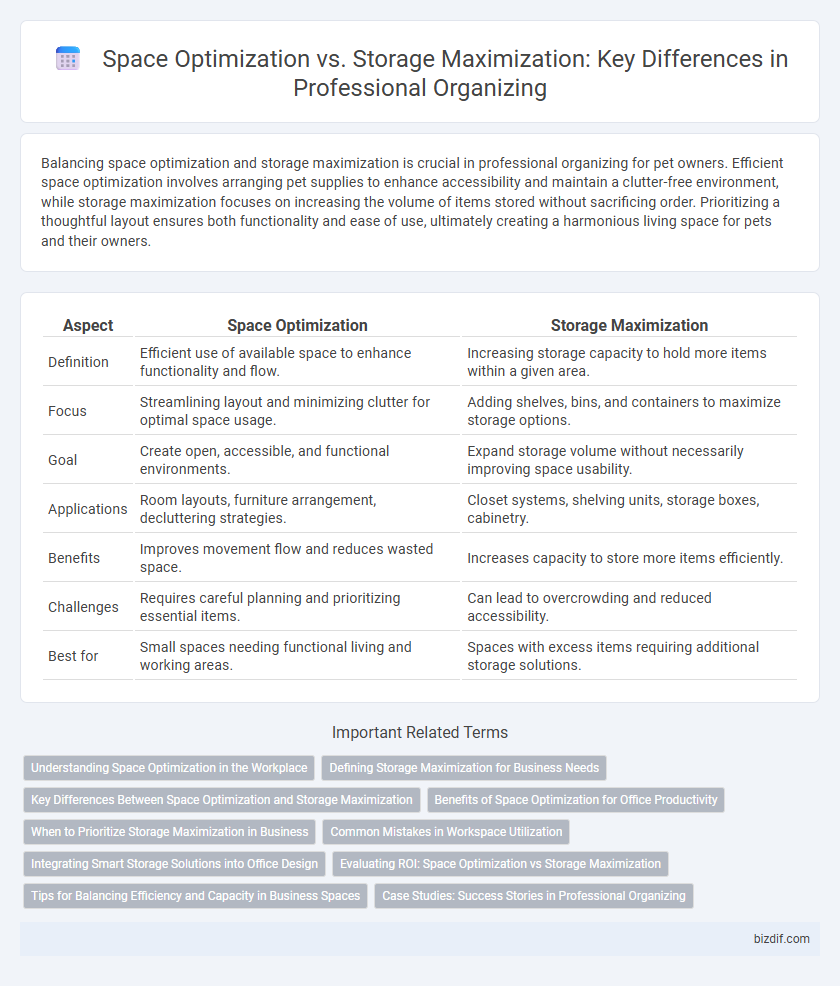Balancing space optimization and storage maximization is crucial in professional organizing for pet owners. Efficient space optimization involves arranging pet supplies to enhance accessibility and maintain a clutter-free environment, while storage maximization focuses on increasing the volume of items stored without sacrificing order. Prioritizing a thoughtful layout ensures both functionality and ease of use, ultimately creating a harmonious living space for pets and their owners.
Table of Comparison
| Aspect | Space Optimization | Storage Maximization |
|---|---|---|
| Definition | Efficient use of available space to enhance functionality and flow. | Increasing storage capacity to hold more items within a given area. |
| Focus | Streamlining layout and minimizing clutter for optimal space usage. | Adding shelves, bins, and containers to maximize storage options. |
| Goal | Create open, accessible, and functional environments. | Expand storage volume without necessarily improving space usability. |
| Applications | Room layouts, furniture arrangement, decluttering strategies. | Closet systems, shelving units, storage boxes, cabinetry. |
| Benefits | Improves movement flow and reduces wasted space. | Increases capacity to store more items efficiently. |
| Challenges | Requires careful planning and prioritizing essential items. | Can lead to overcrowding and reduced accessibility. |
| Best for | Small spaces needing functional living and working areas. | Spaces with excess items requiring additional storage solutions. |
Understanding Space Optimization in the Workplace
Space optimization in the workplace involves strategically arranging furniture, equipment, and workstations to enhance functionality and employee productivity while reducing clutter. Unlike storage maximization, which prioritizes increasing capacity, space optimization focuses on creating efficient layouts that promote flow, accessibility, and comfort. Implementing space optimization techniques can improve communication, boost morale, and make the best use of limited office real estate.
Defining Storage Maximization for Business Needs
Storage maximization for business needs involves efficiently utilizing available storage capacity to accommodate the highest volume of materials, inventory, or equipment without compromising accessibility or workflow. This approach emphasizes tailored solutions such as modular shelving, vertical storage systems, and inventory categorization to enhance operational efficiency. Prioritizing storage maximization supports cost savings on space rental and improves the organization of essential business assets.
Key Differences Between Space Optimization and Storage Maximization
Space optimization prioritizes efficient use of available areas to enhance functionality and flow, while storage maximization focuses on increasing the volume of items stored within a given space. Space optimization integrates design principles and decluttering strategies to create open, accessible environments, whereas storage maximization often involves adding shelving, containers, or vertical storage solutions to hold more belongings. Understanding these differences is essential for tailoring professional organizing solutions that balance usability with capacity in residential or commercial settings.
Benefits of Space Optimization for Office Productivity
Space optimization enhances office productivity by creating a clutter-free environment that promotes focus and efficient workflow. Utilizing ergonomic layouts and adjustable furniture reduces physical strain and allows employees to access essential tools quickly. Optimized spaces also improve natural light distribution and air circulation, fostering a healthier and more motivating workplace.
When to Prioritize Storage Maximization in Business
Prioritize storage maximization in businesses with high inventory turnover or limited retail space where product availability directly impacts sales revenue. Warehouses and retail stores benefit from maximizing storage capacity to accommodate seasonal stock fluctuations and bulk purchasing. Efficient storage systems reduce retrieval time and improve workflow, ensuring operational productivity stays high during peak demand periods.
Common Mistakes in Workspace Utilization
Common mistakes in workspace utilization include prioritizing storage maximization over space optimization, leading to overcrowded areas and decreased productivity. Filling every available space with items rather than strategically organizing essentials compromises workflow efficiency and accessibility. Effective professional organizing balances storage solutions with open, functional space to enhance comfort and task performance.
Integrating Smart Storage Solutions into Office Design
Integrating smart storage solutions into office design enhances space optimization by utilizing multi-functional furniture and modular shelving systems that adapt to changing needs. Advanced vertical storage options and hidden compartments increase usable workspace without clutter, improving employee productivity and overall office aesthetics. Incorporating technology-driven storage like automated filing systems streamlines organization while maximizing available storage capacity efficiently.
Evaluating ROI: Space Optimization vs Storage Maximization
Evaluating ROI in professional organizing reveals that space optimization enhances usability and efficiency by prioritizing decluttered, accessible areas, which often leads to increased productivity and satisfaction. Storage maximization focuses on increasing capacity, but without efficient layout can cause overcrowding and diminished functional value. Investing in space optimization typically delivers a higher return by improving workflow and reducing time spent searching for items, outweighing the benefits of simply adding storage volume.
Tips for Balancing Efficiency and Capacity in Business Spaces
Maximizing storage capacity often leads to cluttered, inefficient work areas, whereas optimizing space focuses on enhancing workflow and accessibility in business environments. Implement modular furniture, vertical storage solutions, and clear labeling systems to balance efficiency with capacity. Regular audits and adaptive layouts ensure that storage meets evolving needs without sacrificing operational fluidity.
Case Studies: Success Stories in Professional Organizing
Case studies in professional organizing highlight that space optimization improves functionality by designing layouts that prioritize movement and usability over mere capacity. Success stories reveal clients experiencing enhanced efficiency and mental clarity once professionals implement tailored systems that fit their unique lifestyle and spatial constraints. These examples demonstrate that maximizing storage without considering spatial flow often leads to cluttered environments, whereas strategic space optimization creates sustainable, organized living and workspaces.
Space optimization vs storage maximization Infographic

 bizdif.com
bizdif.com